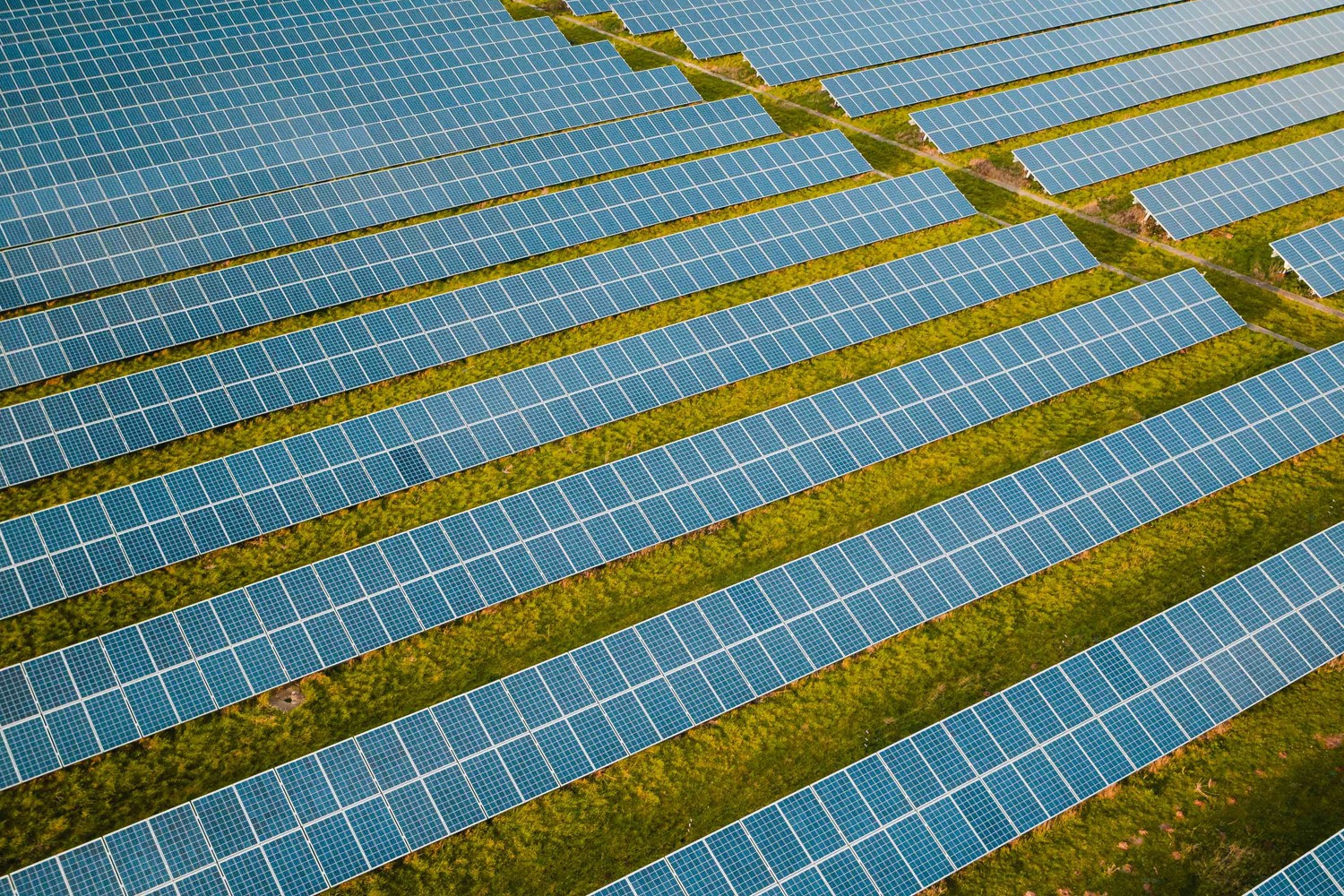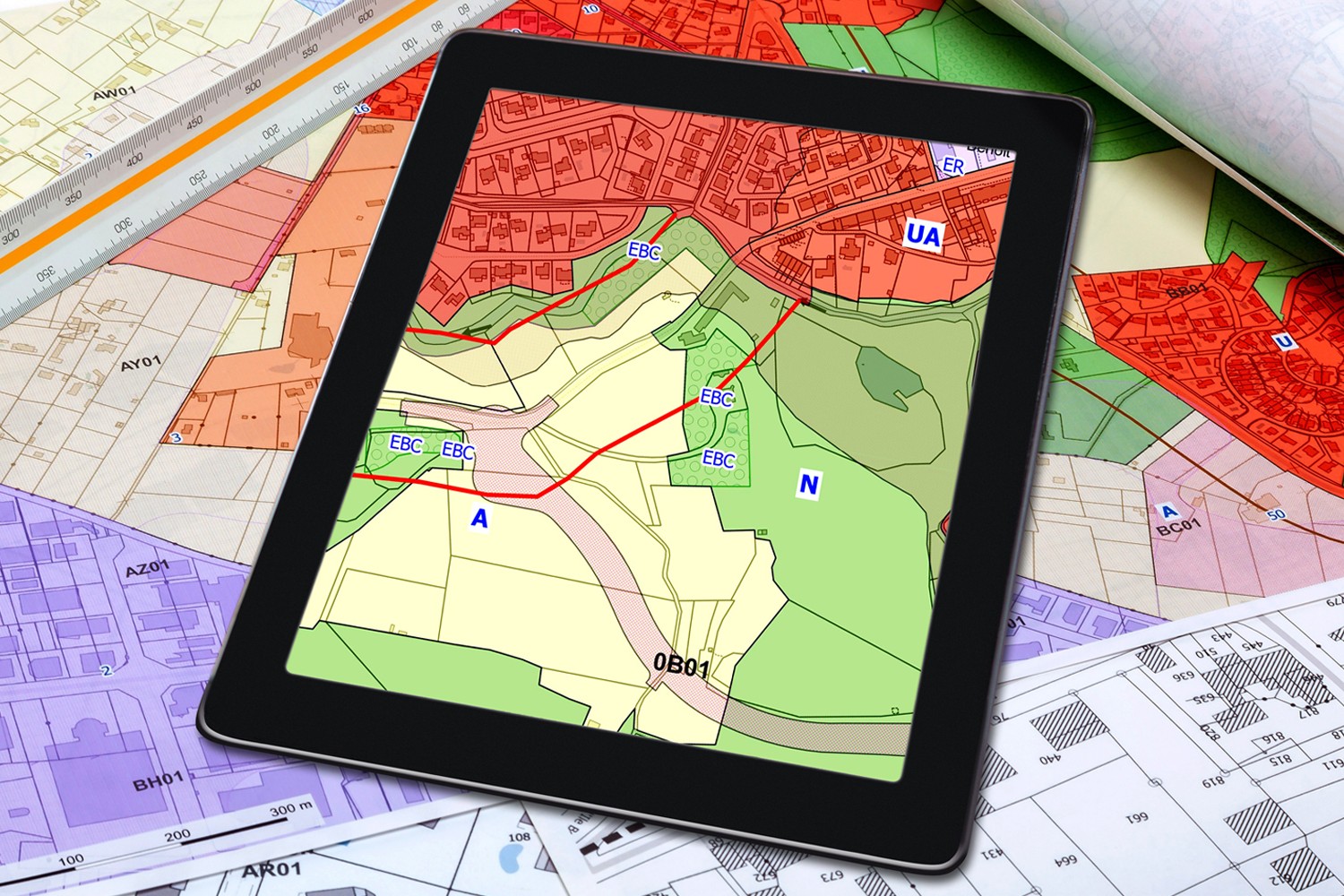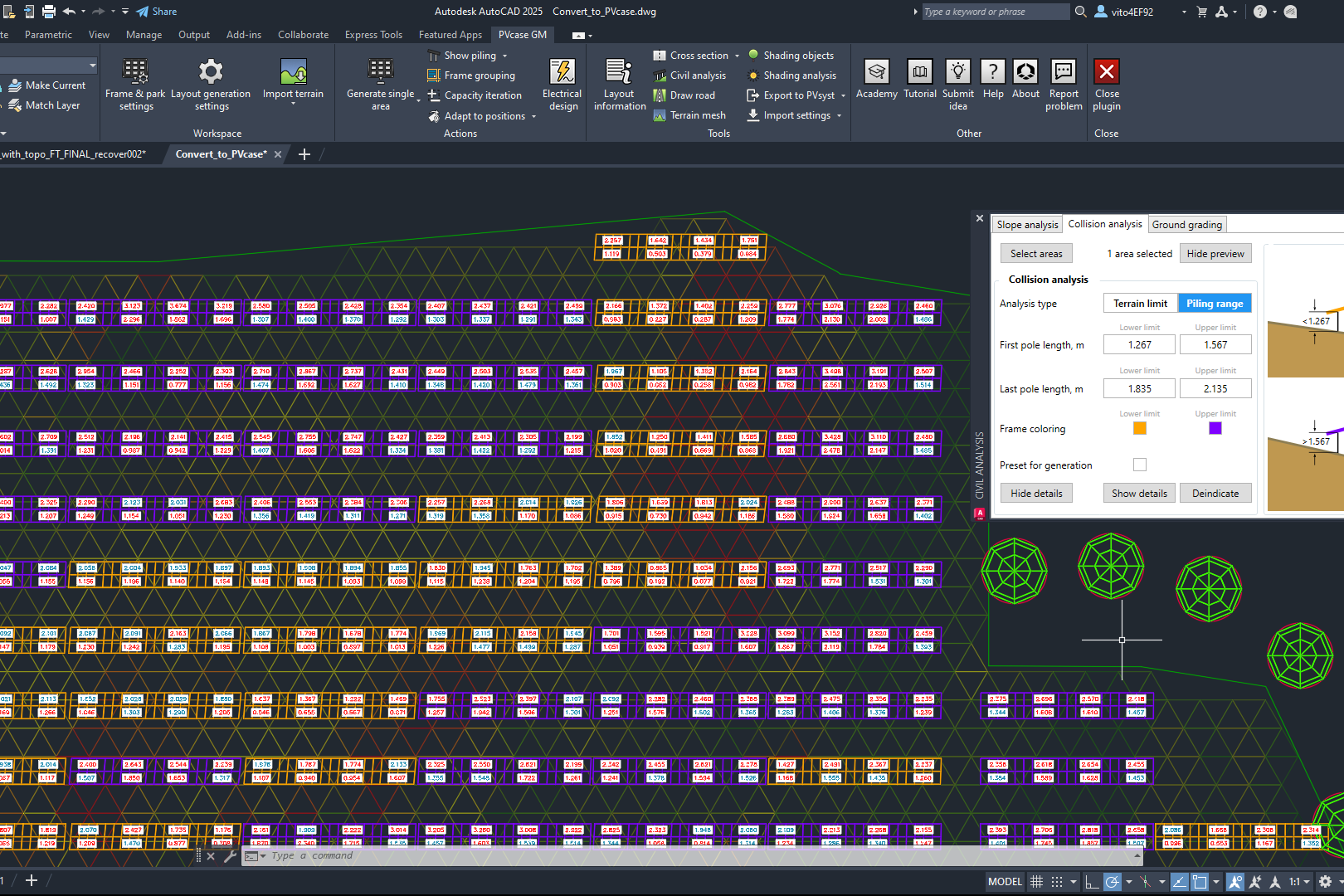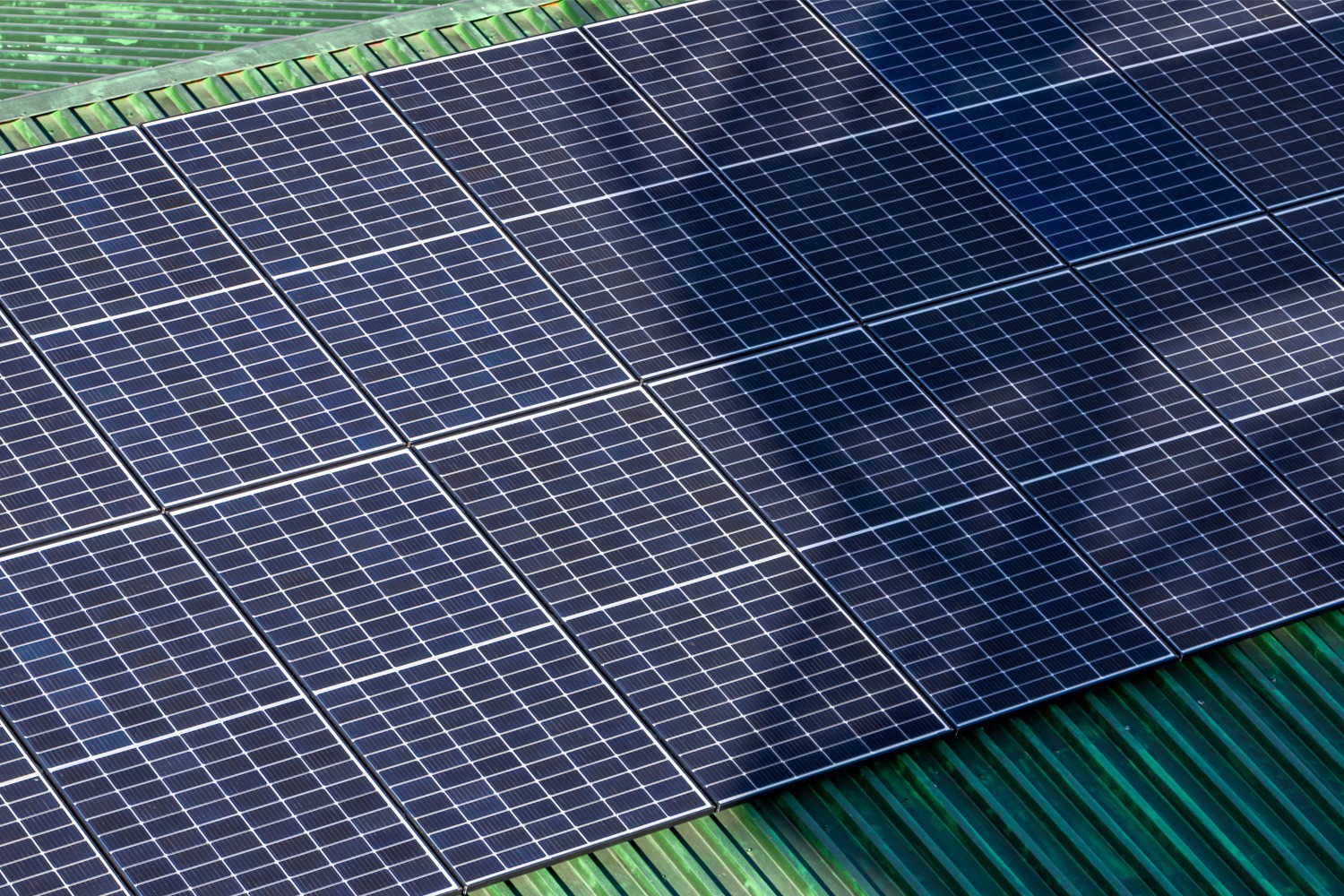Terrain following trackers (TFT) versus traditional single-axis trackers (SAT) has become a popular discussion topic in recent years among developers, construction, and asset management teams. As TFT increase their popularity among more prominent developers, the challenges to accurately design and the ability to compare the cost benefits when implementing one type of tracker versus the other remain a discussion for designers and decision-makers.
We will use this study to compare the amount of site preparation for the same site with different tracker selections: the traditional single-axis trackers, and the terrain-following trackers. This leads to the cost related to site preparation for installation and the project timeline, which are some of the key concerns for both project developers and off-takers.
This study includes two parts: designing terrain-following trackers using PVcase, and the comparison between the terrain-following trackers and traditional single-axis trackers. We will present the key differences in site preparation work for each site, and the physical materials needed when using different types of trackers.
Terrain following trackers design
To create TFT with PVcase, the user should select single-axis trackers, and select terrain following trackers. With TFT, the user will have the option to modify the maximum allowable angle between section parts. There’s also an option to place the pile at the joint and motor locations.

When generating the site with TFT, PVcase will adapt the frames to the terrain profile and identify the frames with angles between sections that exceeded the tolerance.

(Generate a single-axis tracker layout step-by-step instructions here)
Procedure
Before we begin generating the site, it is best practice to generate the terrain mesh. This function allows you to visualize the site, study the existing slopes, and check the quality of the input topography. After generating the terrain mesh to study the slopes in all directions, we identify some of the higher slope areas on the northeastern and southwestern sides of the PV area.
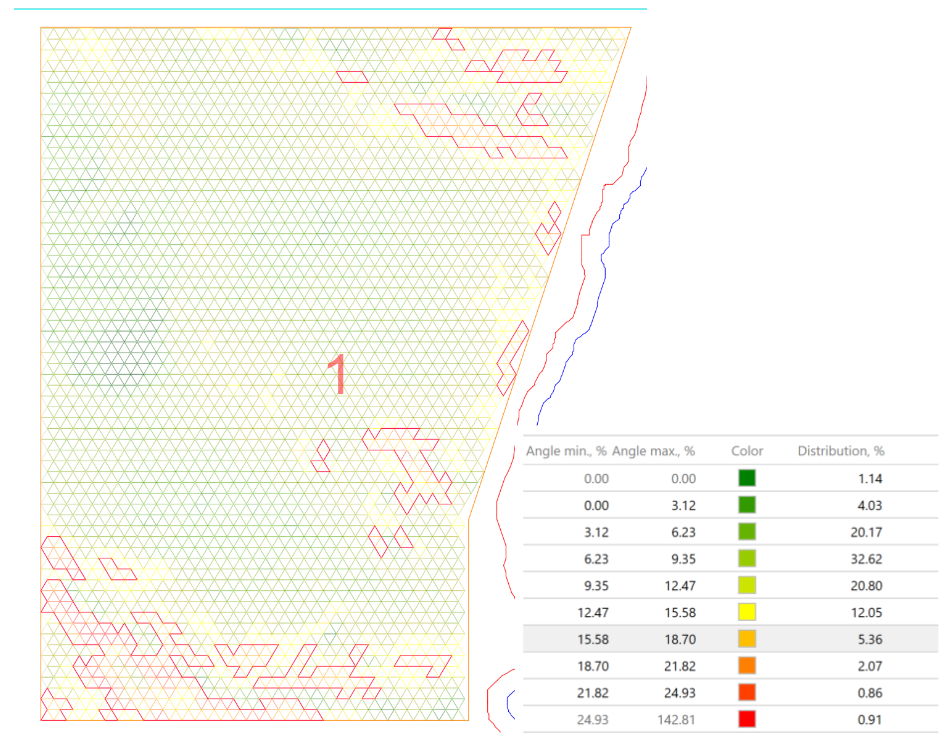
In this study, we will focus on differences between two different types of trackers being generated on the same site of 12.96 acres (564598.16 sqft). Each tracker frame consists of 18 modules with the max slope between sections at 15%
First observation: the site generated with the traditional frames type is slightly higher in capacity.
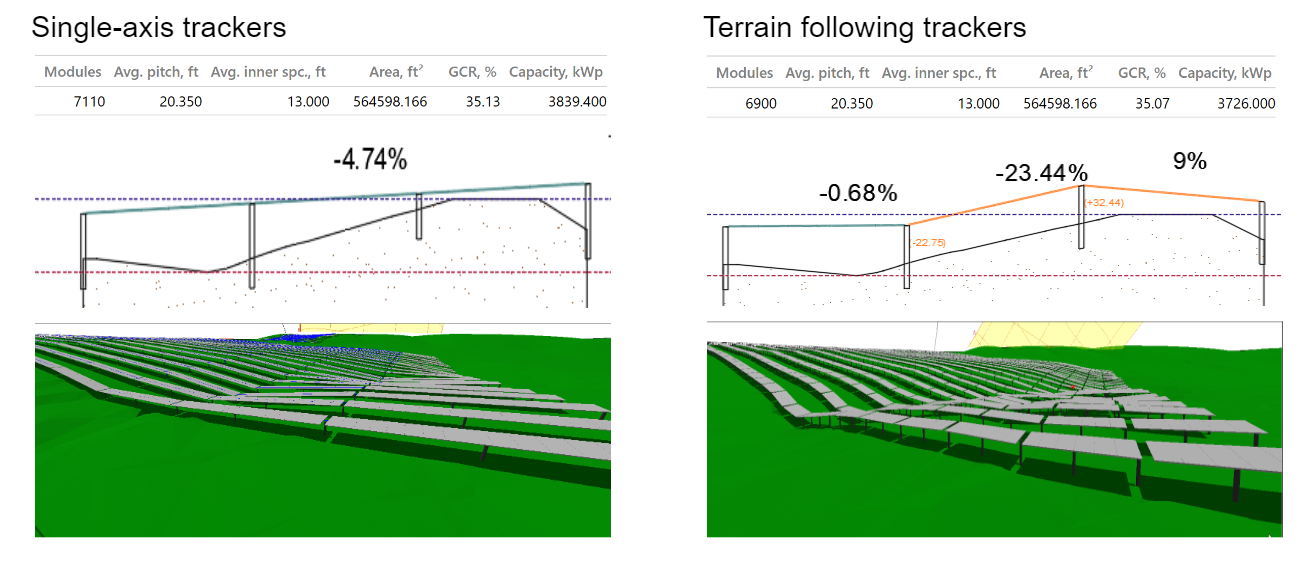
User note: There is no single correct answer for civil analysis. The result can be varied by site conditions, types of trackers, and/or company requirements. In this study, we only present the result of the best-suited solution to minimize the ground grading for this project location.
Slope analysis
We will perform a slope analysis comparison for anything above 3% in north facing, and 5% in south-facing. The software indicates the following:


The slope analysis shows that the terrain slope issue is consistent when using different types of racking systems. 47.59% of the site with traditional trackers and 45.90% of the site with the terrain following trackers were not impacted by the slope of the terrain. (step-by-step instructions here)
Collision analysis
In this study, analyzing collision using the piling height is a better approach because we will be using tracker systems with specific revealing pole requirements. However, in the event you have not had a tracker system in mind, you can use the terrain limit to analyze potential terrain collisions. To take full advantage of the tracker system flexibility, and minimize any unnecessary grading, we set the testing conditions for the pilling height for both at 2% height tolerance, with the lower limit of 4.84 ft (1.48 m) and the upper limit of 5.039 ft (1.54 m) (step-by-step instructions here). With these constraints, the software indicates:
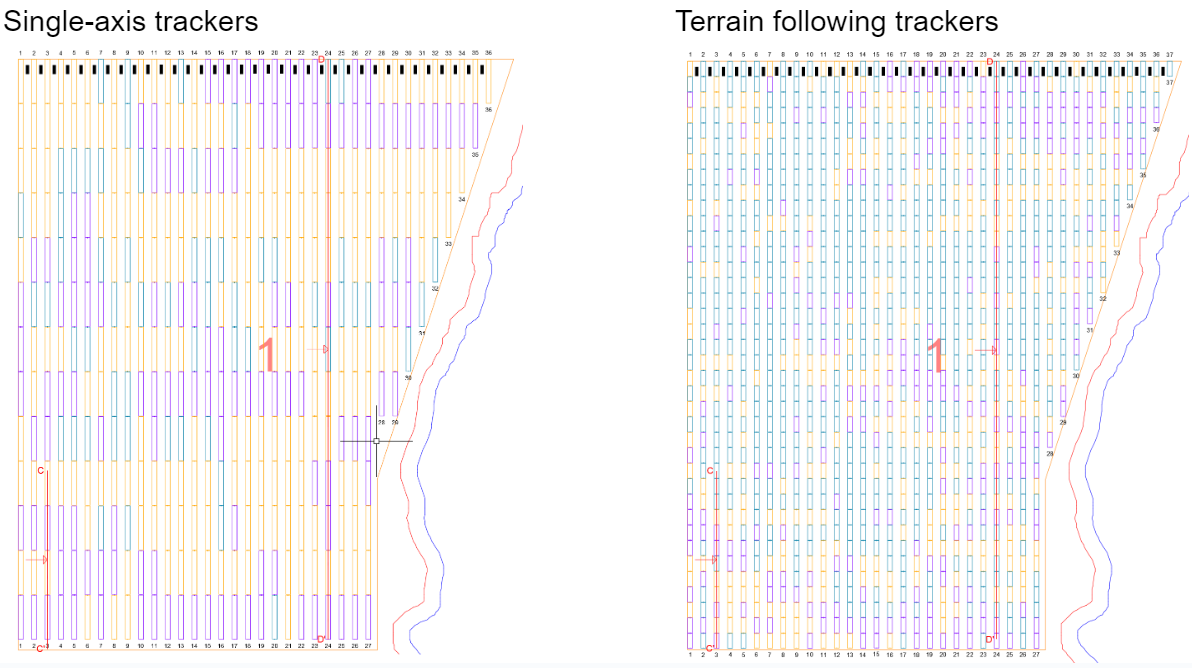

We notice a significantly different result in collision analysis, compared to the results of the slope analysis. 51.90% of the site with traditional trackers requires grading due to lower poles, and 32.91% due to higher poles. On the contrary, the terrain-following tracker site has only 25.71% impacted due to lower pile and 20.53% higher pile deviation.
The potential grading impact of this result means that only 15.19% of the site with traditional trackers does not require any grading, compared to 53.76% of the site that does not need grading when using terrain following trackers.
In the next section, we will be taking a closer look at the result of the grading for the same site, while using these types of trackers.
Grading
The result from the slope analysis indicates that the majority of the frames fall between 3 % north facing and 5 % south-facing slope. There are similar slope impacts for both the cases with the SAT and the TFT. Therefore, grading can be done without having to set a slope limit. In the event your project has more frames impacted by the terrain slopes, it is worth considering setting the slope before grading.
The grading process is intended to solve the frame-terrain collision issues. During collision analysis, we tested the pole reveal values between 4.841 ft to 5.039 ft, so these will be the values we will also use to perform the grading (step-by-step instructions here)


The grading results indicate that the layout with the SAT requires a lot more preparation compared to the layout with the TFT. Specifically, the site with the SAT requires 2.96 times more cut and 3.63 times more fill. This can also be interpreted as the TFT configuration needing 8.47 times additional earth materials to prepare the same location to become a buildable site. This not only has an economic impact but also an environmental impact on the project.
Early on, we used the terrain mesh function to identify higher slope locations. We can now create cross-section views along the trackers to compare the surface differences before and after the grading process. This will help with a better understanding of the earth’s movement that happened during this process (step-by-step instructions here).
Row 3:
Before ground grading
Traditional trackers:

Terrain following trackers:

After ground grading
Traditional trackers:

Terrain following trackers:

Conclusion:
The purpose of this study is to analyze the impact on grading results when using different trackers types: traditional single-axis trackers versus terrain following trackers. The study details how to set up frames for terrain following trackers, and the steps taken to conduct civil analysis: slope analysis, collision analysis, and grading for both scenarios.
The result indicates, despite having the same pole height, the TFT configuration reduces the need for significant ground grading during the site preparation. Both layouts have similar slope impacts from the terrain, but the TFT design shows a significant decrease in the ground grading volume.
There are multiple factors when it comes to deciding which tracker method is the best fit for the project such as finance, scheduling, skilled contractors for installation, and environmental impact. Both methods have their pros and cons. For example, the SAT is well practiced for the majority of contractors and thus the speedy installation and cheaper cost. In contrast, TFT have higher steel and racking costs, but this method shows high potential in minimizing the economic, and environmental burden that otherwise might occur when using traditional trackers. By using PVcase Ground Mount civil analysis tool, each company can decide the best trackers method based on reliable, scientific data.

You might also be interested in:
July 19, 2024
Siting of PV power plants. How to adapt solar designs to complex terrains?
Choosing the wrong PV project site lowers energy output, raises costs, and risks legal issues. PVcase offers solutions. Discover them by reading the article.
July 16, 2024
Overcoming technical challenges in renewable energy projects. How PVcase transformed OHLA’s design process
Explore how OHLA overcame renewable energy design challenges with PVcase, streamlining solar park operations and achieving remarkable business growth.
July 3, 2024
Bridging the renewable energy skills gap. A success story of PVcase, Enery, and the University of Applied Sciences Upper Austria
Discover how PVcase, Enery, and the University of Applied Sciences Upper Austria have collaborated to prepare future solar engineers through an innovative educational initiative,…
July 1, 2024
Top 10 questions from Intersolar Europe 2024, answered
Get answers to the top 10 questions asked during Intersolar Europe 2024 that cover PVcase Prospect's availability, integration of PVcase products, and much more. Your question is…
June 19, 2024
Targeted solar marketing for successful landowner outreach — e-book included!
Discover how innovative strategies and Anderson Optimization's GIS Site Selection can boost solar outreach ROI and conversions. Download the ebook for more insights!
June 3, 2024
PVcase is part of the 42-month long SUPERNOVA project
PVcase, together with 19 partners from all over the world, is part of the 42-month SUPERNOVA project, focusing on O&M and grid-friendly solutions for reliable, bankable, and…
May 29, 2024
PVcase tools are now compatible with AutoCAD 2025!
We’re happy to announce that you can now use PVcase Ground Mound and Roof Mount, our flagship CAD-based tools, on AutoCAD 2025, enjoy its multiple functionalities and integrate…
May 20, 2024
PVcase is the finalist of “The smarter E AWARD” in the Photovoltaics category
We’re the finalists of “The Smarter E AWARD”! Read more about the nomination and dive into the PVcase Integrated Product Suite offering that innovates the industry.
May 14, 2024
Making great designs on good sites—the importance of topo data for PV design
Topo data is the first step in determining the success of your solar project. While the terrain is crucial in this regard, developers should also consider grid connectivity and…
April 29, 2024
How policy can shape future solar energy expansion
Policymakers and regulatory organizations must actively support solar power's growth and renewable energy advancement. Read the article to learn how.
April 25, 2024
Shading Analysis: advanced feature for C&I roof-mount solar projects is live
Shading Analysis is live! Read the article to learn about benefits, capabilities of the tool, and how it can help users and decision-makers.
April 9, 2024
PVcase wins the BNEF Pioneer Award 2024 for innovative solar design solutions
We won the prestigious 2024 BNEF Pioneers Award! Find out how our software contributes to relieving bottlenecks in the deployment of clean power.
March 29, 2024
Sustainable cities: what urban living of the future might look like
From clean energy to green bonds and renewable energy stocks, there are many ways you can invest your money in a sustainable future. Find them out by reading the article.
March 22, 2024
8 ways to invest your money in a sustainable future
From clean energy to green bonds and renewable energy stocks, there are many ways you can invest your money in a sustainable future. Find them out by reading the article.
March 21, 2024
8 business opportunities in renewable energy
There are many potentially lucrative business opportunities in renewable energy. Learn how you can use these opportunities to make money while contributing to the green…

